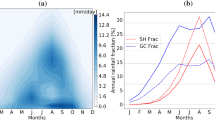Abstract
This paper investigates the relationship between mei-yu and North Atlantic sea surface temperature anomalies (SSTA). Results show that they are significantly associated with each other on the decadal timescale. Both mei-yu precipitation and mei-yu duration are characterized by significant decadal variability. Their decadal components are closely correlated with a triple mode of North Atlantic SSTA in the preceding winter. Regression analysis demonstrates that the wintertime North Atlantic SSTA may impose a delayed impact on East Asia Summer Monsoon (EASM) circulation and mei-yu on the decadal timescale. The persistency of SSTA plays an important role during this course. The triple SSTA mode can persist from winter until late spring. It is suggested that the springtime SSTA may excite a stationary wave-train propagating from west Eurasia to East Asia and exert an impact on mei-yu.
Similar content being viewed by others
References
Bretherton, C. S., M. Widmann, V. P. Dymnikov, J. M. Wallace, and I. Blade, 1999: The effective number of spatial degrees of freedom of a time-varying field. J. Climate, 12, 1990–2009.
Ding, Y., 2004: Seasonal march of the east-Asian summer Monsoon. East Asian Monsoon, C.-P. Chang, Ed., World Scientific Publishing, 21–22.
Ding, Y., and J. C. L. Chan, 2005: The East Asian summer monsoon: An overview. Meteorology and Atmospheric Physics, 89, 117–142.
Gao, H., Y. Wang, and J. He, 2006: Weakening significance of ENSO as a predictor of summer precipitation in China. Geophys. Res. Lett., 33, L09807, doi: 10.1029/2005GL025511.
Grinsted, A., J. C. Moore, and S. Jevrejeva, 2004: Application of the cross wavelet transform and wavelet coherence to geophysical time series. Nonlinear Processes in Geophysics, 11, 561–566.
Gong, D.-Y., and C.-H. Ho, 2003: Arctic oscillation signals in the East Asian summer monsoon. J. Geophys. Res., 108(D2), 4066, doi: 10.1029/2002JD002193.
He, J.-H., L. Qi, J. Wei, and Y. Z. Chi, 2007: Reinvestigations on the East Asian Subtropical Monsoon and Tropical Monsoon. Chinese J. Atmos. Scis., 31, 1257–1265. (in Chinese)
Huang, R. H., and Y. Wu, 1989: The influence of ENSO on the summer climate change in China and its mechanism. Adv. Atmos. Sci., 6, 21–32.
Ju, J. H., J. Cao, and J. Ren, 2005: Possible impacts of the Arctic Oscillation on the interdecadal variation of summer monsoon rainfall in East Asia. Adv. Atmos. Sci., 22, 39–48.
Kalnay, E., and Coauthors, 1996: The NCEP/NCAR 40-Year Reanalysis Project. Bull. Amer. Meteor. Soc., 77, 437–471.
Li, C. Y., and M. Q. Mu, 2001: Influence of the Indian Ocean Dipole on Asian Monsoon Circulation. CLIVAR Exchange, 6, 11–14.
Long, Z. X., J. Pan, and C. Y. Li, 2003: Influences of anomalous summer monsoon over the South China Sea on climate variation. Acta Meteorologica Sinica, 17, 118–129.
Liu, X., and M. Yanai, 2002: Influence of Eurasian spring snow cover on Asian summer rainfall. International Journal of Climatology, 22, 1075–1089.
Lu, R., B. Dong, and H. Ding, 2006: Impact of the Atlantic Multidecadal Oscillation on the Asian summer monsoon. Geophys. Res. Lett., 33, L24701, doi: 10.1029/2006GL027655.
Marshall, J., and Coauthors, 2001: North Atlantic climate variability: Phenomena, impacts and mechanisms. International Journal of Climatology, 21, 1863–1898.
Ogi, M., Y. Tachibana, and K. Yamazaki, 2003: Impact of the wintertime North Atlantic Oscillation (NAO) on the summertime atmospheric circulation. Geophys. Res. Lett., 30, 1704, doi: 10.1029/2003GL017280.
Plumb, R. A., 1985: On the three-dimensional propagation of stationary waves. J. Atmos. Sci., 42, 217–229.
Rayner, N. A., D. E. Parker, E. B. Horton, C. K. Folland, L. V. Alexander, D. P. Rowell, E. C. Kent, and A. Kaplan, 2003: Global analyses of sea surface temperature, sea ice, and night marine air temperature since the late nineteenth century. J. Geophys. Res., 108(D14), 4407, doi: 10.1029/2002JD002670.
Sung, M.-K., W. Kwon, H. Back, K. Boo, G. Lim, and J. Kug, 2006: A possible impact of the North Atlantic Oscillation on the east Asian summer monsoon precipitation. Geophys. Res. Lett., 33, L21713, doi: 10.1029/2006GL027253.
Tan, Y. K., J. H. He, and C. W. Zhu, 1999: Impact of Eurasian winter snow cover on the Northern Hemisphere summer circulation and its possible relation to East Asia pacific teleconnection pattern. Chinese J. Atmos. Sci., 23, 152–160. (in Chinese)
Weng, H., K. Ashok, S. K. Behera, S. A. Rao, and T. Yamagata, 2007: Impacts of recent El Niño Modoki on dry/wet conditions in the Pacific rim during boreal summer. Climate Dyn., 29, 113–129.
Wu, L., and Z. Liu, 2005: North Atlantic decadal variability: Air-sea coupling, oceanic memory, and potential Northern Hemisphere Resonance. J. Climate, 18, 331–349
Wu, R., and L. Chen, 1998: Decadal variation of summer rainfall in the Yangtze-Huaihe River valley and its relationship to atmospheric circulation anomalies over East Asia and western North Pacific. Adv. Atmos. Sci., 15, 510–522.
Wu, R., and B. Wang, 2002: A contrast of the East Asian summer monsoon-ENSO relationship between 1962–77 and 1978–93. J. Climate, 15, 3266–3279.
Xu, H. M., J. H. He, and Y. H. Yao, 1999: Interannual variability of the mei-yu onset and its association with the atmospheric circulation in the previous winter and possible causes. Journal of Nanjing Institute of Meteorology, 22, 246–253. (in Chinese)
Yang, S., and L. Xu, 1994: Linkage between Eurasian winter snow cover and regional Chinese summer rainfall. International Journal of Climatology, 14, 739–750.
Ye, H., 2000: Decadal variability of Russian winter snow accumulation and its associations with Atlantic sea surface temperature anomalies. International Journal of Climatology, 20, 1709–1728.
Ye, H., and Z. Bao, 2005: Eurasian snow conditions and summer monsoon rainfall over South and Southeast Asia: Assessment and comparison. Adv. Atmos. Sci., 22, 877–888.
Zhang, Q. Y., and S. Y. Tao, 2003: The anomalous subtropical anticyclone in western Pacific and their association with circulation over East Asia during summer. Chinese J. Atmos. Sci., 127, 369–380. (in Chinese)
Author information
Authors and Affiliations
Corresponding author
Rights and permissions
About this article
Cite this article
Gu, W., Li, C., Wang, X. et al. Linkage between mei-yu precipitation and North Atlantic SST on the decadal timescale. Adv. Atmos. Sci. 26, 101–108 (2009). https://doi.org/10.1007/s00376-009-0101-5
Received:
Revised:
Published:
Issue Date:
DOI: https://doi.org/10.1007/s00376-009-0101-5




